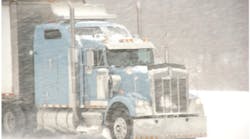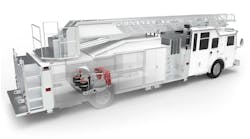Cold weather solutions for fleets
The 2018-2019 winter season never seemed to end here in Wisconsin. Much of the Midwest saw record snowfalls and bitter cold temperatures.
In my days as a service manager, the rule of thumb was that cold iron breaks and the winter season was usually a profitable part of the dealership’s overall business plan. Sales of tire chains, fuel additives, and other cold weather products were sold so frequently we could hardly keep the shelves full.
Challenges with idling
While today’s modern engines tend to start better at colder temperatures compared to older models, wear and tear on an engine is highest when idling with no fuel miles-per-gallon (mpg) to account for.
In addition, current emission systems on these modern engines still don’t like cold-weather operation. For instance, when idling the engine for an extended period of time, the diesel particulate filter (DPF) will get “face coated” with soot inside the filter. This can cause multiple issues with exhaust pressure sensors, diesel exhaust filter (DEF) doser malfunctions, and excessive regenerations to clean out the soot. Combine this with fuel-related issues, and the emissions system stands to be one of the highest cost items for a fleet.
One cold weather solution available to help address these issues is specifying a fuel tank heater. These products used to be very popular back in the 1980s. With the advent of unit injected engines, the temperature of the fuel returning from the engine was high enough that the tanks were kept warm, thus reducing fuel gelling issues. Today’s modern engines with common rail fuel systems, however, do not have as much fuel return so fuel heaters can still benefit fleets in colder climates.
The case for fuel-fired heaters
The main point is to reduce cold weather idle. The number one way to do this is to add a fuel-fired heater, available as either a bunk air heater or engine coolant heater.
Bunk air heaters
A bunk air heater option has been a common specification for many national fleets so drivers can sleep in comfort without idling the engine.
Besides the ease of use and low cost of maintenance, bunk air heaters can run up to 24 hours on a single gallon of fuel, compared to approximately 1 gallon of fuel consumed per hour idling the engine. Considering the average cost of diesel fuel is $3 per gallon, with a driver spending 10 hours a day in the sleeper berth, based on a 120-day average winter season fuel savings alone could be as much as $3,600 annually.
That is just the fuel savings and not inclusive of the emission systems’ cost issues that will come with the cold weather idle. With this calculation, the bunk air heater return on investment would occur just after one season.
Engine coolant heaters
Another solution for fuel savings is adding an engine coolant heater. This is one of the areas often overlooked when adding equipment to a truck or other machinery such as skid steers, day cabs, trailer spotting units, or remote equipment that does not have an electrical plug available for the engine-mounted block heater.
Also designed to help reduce idle time, an engine coolant heater acts as a mobile block heater that circulates hot coolant throughout the engine, not just a small area of the engine block. It is mounted on the vehicle and stays with the vehicle wherever it goes. This means electrical plug-ins or cords are not needed. To use these heaters, fleets simply set the timer to turn on the heater a couple of hours before departure to have a warm engine before the start of the day.
Maintenance for these systems
All mechanical products require maintenance, and a system heater is no different. A heater has moving parts that are replaceable.
The number one action fleets can take for heater system maintenance is to run the heater, air, or coolant for about 15 minutes each month of the year. This helps keep the fuel system primed, the fuel pump’s internal components lubricated and moving, and internal combustion parts of the heater get cleaned out by burning off soot that may have developed inside the heater. Another benefit to running the heater each month of the year is increased reliability of the heater starting when it’s needed most: during cold weather.
Some other maintenance suggestions include replacing the fuel filter annually. Visual smoke coming out of the heater exhaust pipe when the heater starts may indicate the heater combustion process is in need of service. Fleets should then consider replacement of the fuel atomizer screen when smoking occurs. Another consideration would be to proactively replace the fuel atomizer screen annually during a preventive maintenance inspection to reduce downtime.
There may come a day when engine coolant heaters will become standard equipment to help preheat the engine and DEF. These systems are designed to help vehicles run better, last longer, save fuel, and reduce emissions, so everybody benefits from these cold weather solutions.




